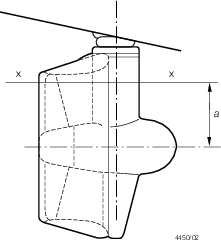4.3.1 Where the propeller is contained within a
nozzle, the equivalent rudder stock diameter in way of tiller, used in Table 1.4.1 Connection of tiller to
stock in Pt 14, Ch 1 is to be determined as follows:

where
|
V
|
= |
maximum service speed, in knots, which the craft is designed to
maintain under thruster operation |
|
A
N
|
= |
projected nozzle area, in m2, and is equal to the length
of the nozzle multiplied by the mean external vertical height of the nozzle |
|
X
PF
|
= |
horizontal distance from the centreline of the steering tube to the
centre of pressure, in metres. The position of the centre of pressure is
determined from Table 3.2.5 Position of centre of
pressure . |
The corresponding maximum turning moment, M
T, is to be determined as follows:
4.3.2 In addition
to the requirements of Pt 3 General Requirements and Constructional Arrangements the scantlings
of the nozzle stock or steering tube are to be such that the section
modulus Z against transverse bending at any section x-x
is not less than:

Figure 3.4.1 Azimuth thruster
4.3.3 The scantlings
of nozzle connections or struts will be specially considered. In the
case of certain high powered craft, direct calculation may be required.
4.3.4 Where
the propeller is not contained in a nozzle, the scantlings in way
of the tiller will be subject to special consideration.